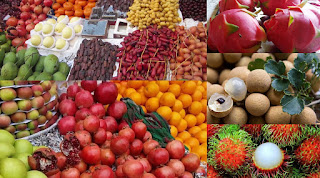Bangladesh
has recently achieved considerable success in producing fruits. According to
the World Food and Agriculture Organization (FAO), fruit production in
Bangladesh has increased at an average rate of 11 percent per year for the past
18 years, which has not happened in any other country in the world.
Foreign
fruits on the soil of Bangladesh:
We call Lichu
(litchi) a Bangladeshi fruit. But once, this litchi fruit also came from far
away China, and even the name Lichu is not a Bangla name, it’s Chinese. Thus,
many of the fruits that we now know as indigenous fruits, have come from abroad
and made their way to the soil of our country. They have slowly become popular.
That trend continues, and will be in the future.
Over the past
decade, at least 20 foreign fruits have arrived in this country. These are
Strawberry, Dragon Fruit, Malta, Rambutan, Sour Soap or tok aata, Alobokhara,
Mangosteen, Canistel or Zaman Fruit, Passion Fruit, Persimmon, Avocado, Cocoa,
Grape, Peach fruit, Cherry, Longan, Saudi Khorma, Bread Fruit, Shantol, Rock
Mellon, etc.
There are
also many exotic fruits came before, such as almonds. In addition, some fruits
that were in this country, but with the advent of some new varieties, there has
been a great change in the cultivation and production of those fruits, such as Thai
guava. With these varieties of Thailand guava, we can now eat delicious guavas
all year long.
Likewise, the
delicious mango varieties Katimon which can be found around the year or un-season,
Brunei king mango which weighing two or three kilograms, mango palmar in red
gourd, long varieties of yellow mango like bananas, and even Amrapali which are
soaked in the soil of the country. Thai Jamrul, sweet arbaroi, sweet cinnamon,
sweet karmacha, sweet kamranga, color sharifa, dwarfs coconut, non-seasonal watermelons
etc are now available here.
Bangladeshi Local
Fruits:
The most
common and popular fruit varieties that cultivated commercially inside the
country, such as jackfruit, mango, guava, banana, pineapple, watermelon, papaya,
litchi, coconut, jujube (kul-boroi), various lemons. These are called seasonal conventional
fruits of Bangladesh.
Among the
obsolete fruits of the country are bell (Bengal quince), Kodbel/bael, tetul (tamarind),
Amra fruit (hog plum), olive, Jaam/Jam/Kalojaam (Jambul), jamrul (water apple),
gulapjam (rose jaamun), orange, chinar, lukuki/torfoi, deua, kamranga,
karmacha, etc. Various wild fruits are bet-fal, chapalish jackfruit, timtoah, akura,
butijaam, putijaam, kaufal, boiychi, wood peanut, wild peanut, wild/forest
mango etc.
Reduce fruit
import:
Due to the
scarcity and demand of fruits, there are currently some exotic fruits available
in this market. Among these are apples, grapes, oranges, pears, pomegranate,
kiwi, dragon fruit, persimmon, mango, avocado, etc. Foreign fruit imports have
been gradually declining due to continuous fruit production in the country and
interest of human in domestic fruits. The quantity of fruit imported from
abroad was around 3,56000 tons in 2017-18 year but in 2018-19 it was reduced to
around 3,00,000 tons.
Research on
fruits:
A total of 177
modern varieties of 40 different species of fruits have been invented by
various research and educational institutes in this country. Of these:
- Bangladesh Agricultural Research Institute (BARI) invented 84 varieties fruits of 35 species
- Bangladesh Agricultural University has invented 84 varieties fruits of 24 species
- Patuakhali University of Science and Technology has invented 7 varieties of 5 species
- Bangabandhu Sheikh Mujibur Rahman Agriculture University has invented two varieties of two species
In addition,
several technologies have been developed for fruit cultivation. Fruit
production is increasing day by day with the expansion and use of these
varieties and technologies.
Thanks,
Related:
Rice Varieties in Bangladesh | BINA and BRRI





















